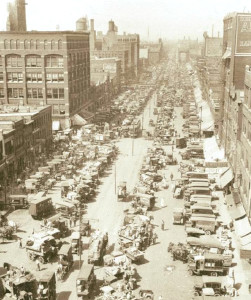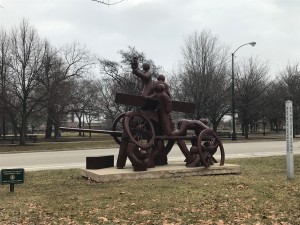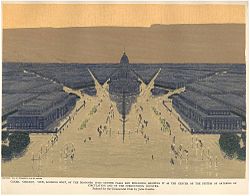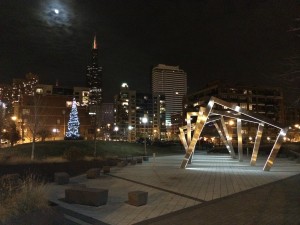First settlements – From its earliest days, the West Loop has been an area of contrast. In the mid-1800s, while Chicago’s poor were erecting shanties on the prairie land west of the river, nearby some of the wealthiest families in Chicago lived in large homes near Union Park and along Washington Boulevard, Jackson Boulevard, and Ashland Avenue.[1]
Randolph-Fulton Market – Strategically positioned as the hub of waterway and rail commerce for the Midwest and beyond, Chicago has long been an economic powerhouse. Much of this success traces back to the agricultural processing and distribution systems that were defined by its famous historic markets. The Fulton-Randolph Market is the oldest and last of the great Chicago wholesale markets, which included the Union Stockyards and the Maxwell Street Market. The Fulton-Randolph Market took shape in 1850 when the Town of Chicago erected the Randolph Street Market Hall at Randolph and Desplaines. While Randolph Street focused on produce, Fulton Market Street two blocks to the north housed much of the city’s meatpacking industry. The markets expanded westward, eventually reaching Ogden as wholesalers displaced from other downtown markets joined the area. The busy markets also drew other businesses – first those associated with the markets, like bakeries and barrel makers, then unrelated businesses like furniture makers and foundries that introduced manufacturing to the West Loop. Many of the historic warehouses, commission houses, and meatpacking buildings that still line these streets were built to support the bustling Nineteenth Century market. [2]
Haymarket Square Riot – As the industrial revolution took hold in Chicago, labor unions gained strength as they worked to improve conditions for workers. In an effort to reduce their work day to eight hours, the Federation of Organized Trades and Labor Unions staged a strike on May Day, 1886. After an altercation between police and the strikers led to the death on the third day of the strike, a rally was staged at Haymarket Square (in present day West Loop) to protest police brutality. The ensuing riot led to four more deaths and subsequent trials, but also served as a rallying cry for the eight hour work day movement.[3] Though the Kennedy Expressway cut through Haymarket Square, a memorial statue now sits just north of Randolph Street on the east side of Desplaines Street.
Plan of Chicago – The area held an important position in Danial Burnham’s 1909 Plan of Chicago, with the intersection of Congress and Halsted set aside as a municipal center for the city including a domed civic center building that would tower over the city.
Skid Row – As the Great Depression set in, the area’s economic activity ground to a halt, with many warehouses being abandoned. The introduction of Interstate 90 (later named the Kennedy Expressway) between Jefferson and Halsted and Interstate 290 (Eisenhower Expressway) in place of Congress Parkway west of Halsted in the 1950s and 60s splintered existing West Side neighborhoods.[4] Crime rates increased through the 1960s and the area came to be known as Skid Row, “a stretch that into the ’70s was notorious…where flophouses charged 80 cents a night for a cot and where missions competed with saloons for the souls of the men who milled around the streets.”[5]
Harpo Studios – In 1988, a team of investors including Oprah Winfrey purchased a former cold storage warehouse at 1058 W. Washington Blvd. and established the building as the headquarters for Harpo Studios.[6] Starting in 1989, the Oprah Winfrey Show was filmed at this location, shining a spotlight on the West Loop. As of the most popular shows on television, the Oprah Show drew thousands of visitors each year, in addition to its 200 employees.[7] The resulting economic impact to the West Loop is still felt today.
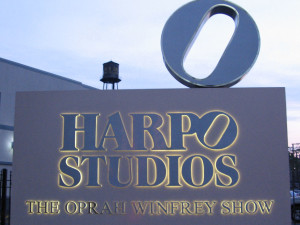 Restaurant Row – After Oprah established her anchor in the West Loop, a series of successful restaurants were soon to follow. Italian mainstay Vivo (recently closed[8]) was the first to arrive in 1991 (coincidentally the year the Bulls began winning championships), followed by Marché (now Nellcôte), Red Light (now Little Goat), and Blue Point Oyster Bar (now Haymarket Pub & Brewery), followed by One Sixtyblue (now BellyQ), Blackbird, and Avec. These restaurants formed what has become known internationally as the Randolph Street “Restaurant Row”.[9]
Restaurant Row – After Oprah established her anchor in the West Loop, a series of successful restaurants were soon to follow. Italian mainstay Vivo (recently closed[8]) was the first to arrive in 1991 (coincidentally the year the Bulls began winning championships), followed by Marché (now Nellcôte), Red Light (now Little Goat), and Blue Point Oyster Bar (now Haymarket Pub & Brewery), followed by One Sixtyblue (now BellyQ), Blackbird, and Avec. These restaurants formed what has become known internationally as the Randolph Street “Restaurant Row”.[9]
1996 Democratic Convention – The rejuvenation of the West Loop continued as the City made major infrastructure investments in the area ahead of the 1996 Democratic National Convention at the United Center. However, the West Loop still struggled to find its identity as the 21st Century approached.
Post-recession development – The West Loop emerged from the Great Recession of the mid-2000s as one of the hottest development markets in Chicago. Between 2008 and 2016, over 4,100 residential units were built in the neighborhood, with thousands more planned.[10] Led by Sterling Bay, Shapack Partners, R^2 Companies, Michigan Avenue Real Estate, and others, the development boom is showing little sign of slowing down.
Many factors combined to spur this growth, including the convenience associated with living blocks from major employment sites downtown and a societal shift towards the urban lifestyle. Restaurant Row on Randolph, popular art galleries along Washington Boulevard, and nightclubs in Fulton Market also add to the energy of the community. In addition, strategic developments have made the West Loop a particularly attractive place to live and play, especially the 2009 reopening of Mark T. Skinner West Elementary (recently rated by Chicago Magazine as the top public school in the city[11]) and the dedication of Mary Bartelme Park in 2010.
Residential growth in the West Loop over the last ten years has been matched by the explosion of new businesses that have planted roots in the community. This has added more convenience for residents and made the neighborhood a hub for employers, led by Google, Boeing, Uber, Motorola, and United Airlines. The announcement of McDonald’s decision to relocate their global headquarters from Oak Brook to the former site of Harpo Studios by 2018 has signaled a sea change for the West Loop.[12] In addition to being the most visible example of the corporate migration from the Chicago suburbs to downtown[13], it has already led to developers to plan for a McDonald’s “vendor village” of developments for businesses associated with the fast food giant. As with Harpo Studios a generation earlier, the West Loop may feel the effects of McDonald’s arrival for decades to come.
The things that make the West Loop a great place to live and work also make it a top destination for tourists. World-class restaurants line our streets, including Michelin star-rated Oriole, Blackbird, Roister, Sepia, and Smyth[14] and other citywide favorites like Au Cheval, Avec, Girl & the Goat, Greek, Islands, Lena Brava, Monteverde, and Next. After many years with the Crowne Plaza as the only large hotel in the West Loop, Soho House opened in 2014 and has become a gathering place for networking and collaboration amongst those in the creative fields.[15] The success of Soho House, combined with the huge growth of businesses of all sizes, has led to a sharp increase in the number of planned West Loop hotels, with more than 850 rooms scheduled for delivery in the next eighteen months.
Posted: February, 2018
[1] http://westloop.org/about/history/
[2] https://www.cityofchicago.org/content/dam/city/depts/zlup/Historic_Preservation/Publications/Fulton_Randolph_Market_District_Prelim_Sum.pdf
[3] http://www.illinoislaborhistory.org/the-haymarket-affair/
[4] http://www.encyclopedia.chicagohistory.org/pages/878.html
[5] http://articles.baltimoresun.com/1996-08-21/news/1996234102_1_chicago-river-chicago-life-madison-street
[6] http://www.chicagoarchitecture.info/Building/1342756910/Harpo-Studios.php
[7] http://www.encyclopedia.chicagohistory.org/pages/2693.html
[8] http://chicago.eater.com/2016/7/1/12079930/vivo-west-loop-closing-amk-replacing
[9] http://www.chicagomag.com/Chicago-Magazine/May-2012/Best-New-Restaurants-2012-How-Randolph-Street-Became-a-Foodie-Destination/
[10] http://www.chicagotribune.com/classified/realestate/ct-booming-west-loop-re-0911-20160908-story.html
[11] http://www.chicagomag.com/Chicago-Magazine/September-2016/Best-Public-Schools/Chicago/
[12] https://www.dnainfo.com/chicago/20160601/west-loop/mcdonalds-plans-move-headquarters-old-harpo-studios-lot-report
[13] http://www.chicagotribune.com/business/ct-company-moves-suburbs-to-city-20160615-htmlstory.html
[14] http://www.chicagobusiness.com/article/20161102/BLOGS09/161109973/26-chicago-restaurants-awarded-michelin-stars
[15] http://www.chicagotribune.com/business/ct-soho-house-0810-biz-20140810-story.html

